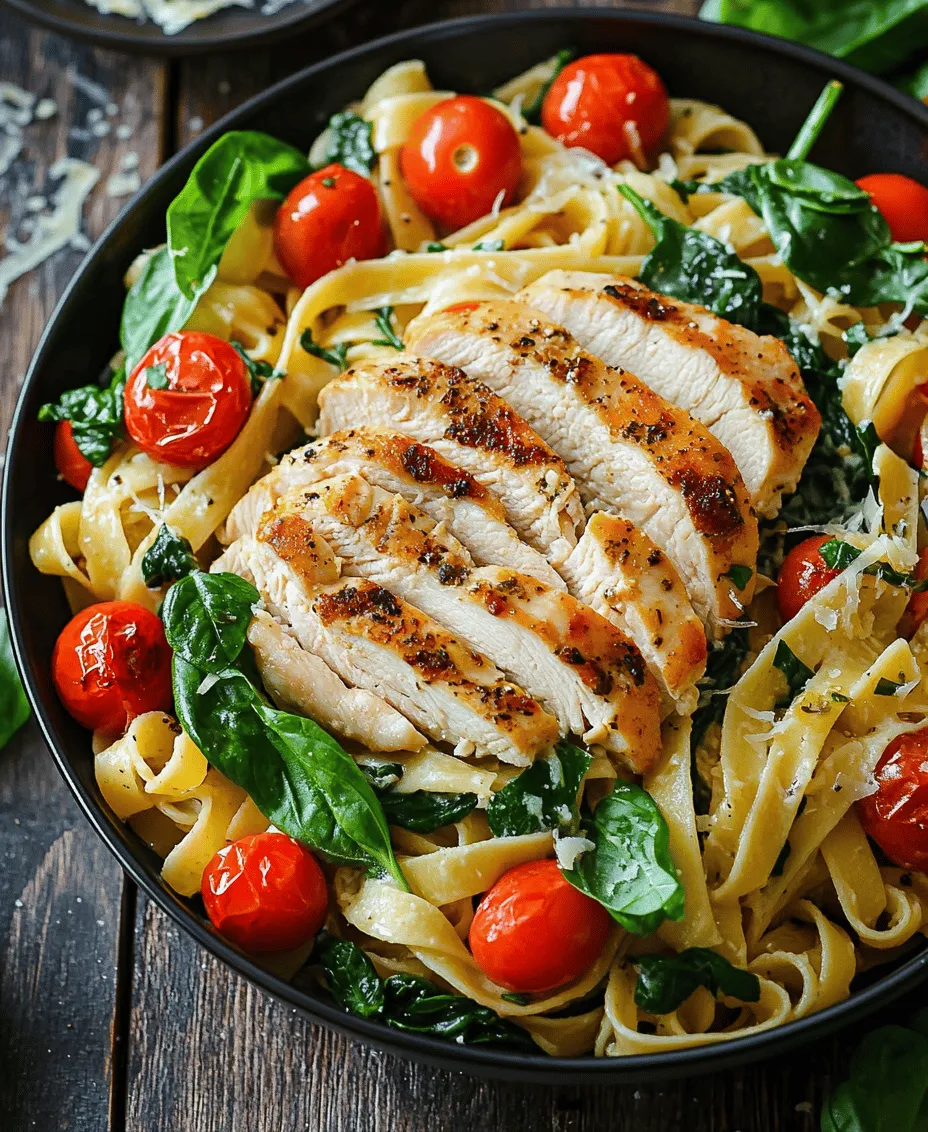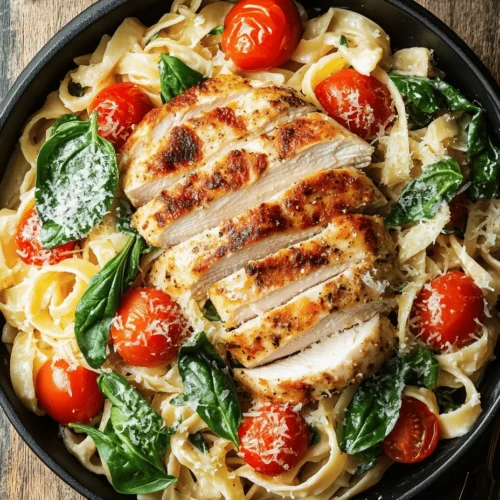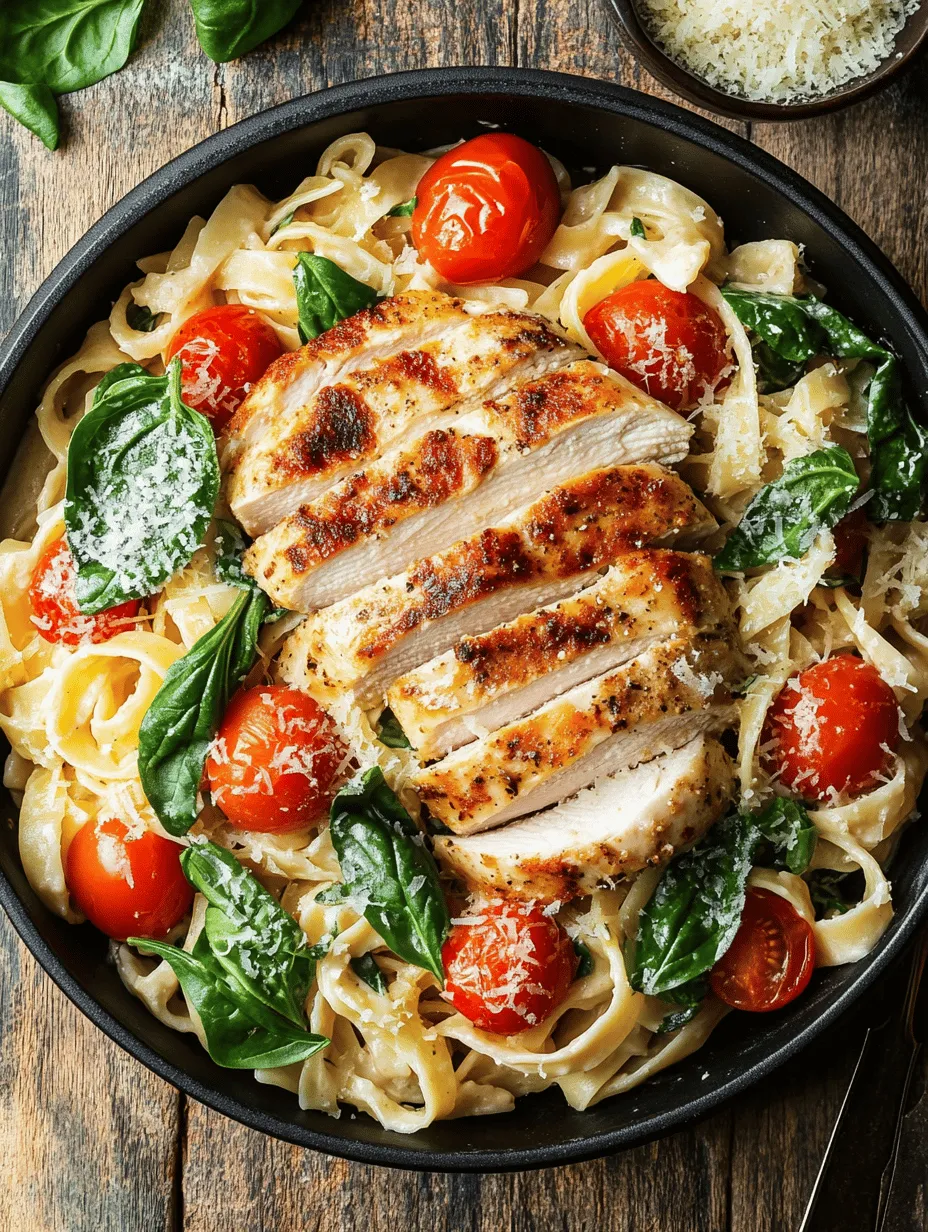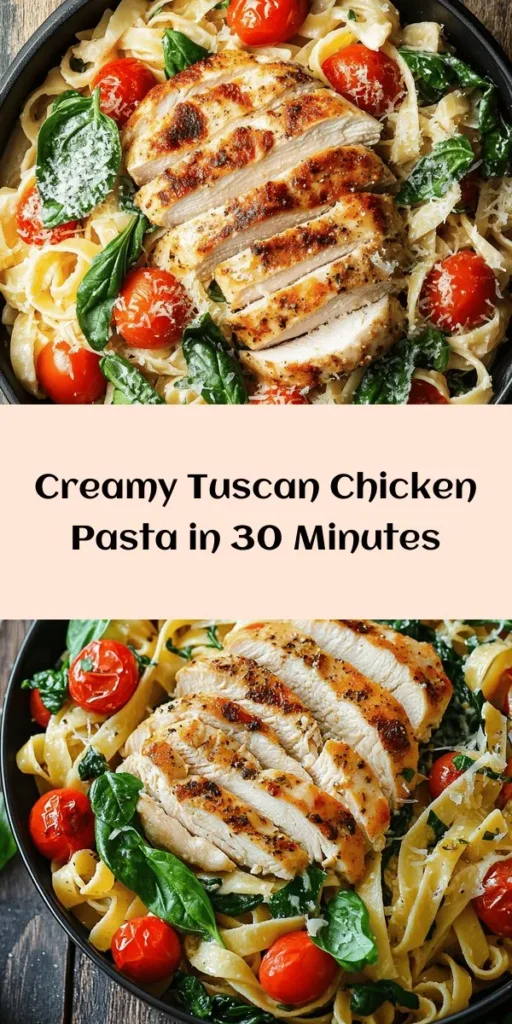Tuscan Chicken Pasta is a delightful and vibrant dish that brings the essence of Italy right to your kitchen. This recipe is famed for its rich flavors and comforting textures, making it a favorite for both novice cooks and seasoned chefs alike. Combining tender chicken, fresh vegetables, and creamy sauce, Tuscan Chicken Pasta offers a deliciously satisfying meal that’s perfect for any occasion – from a casual weeknight dinner to a special gathering with friends.
Originating from the picturesque region of Tuscany, this dish embodies the heart of Italian cooking: simple, high-quality ingredients that come together to create something truly special. The appeal of Tuscan Chicken Pasta lies not only in its taste but also in the ease of preparation. With just a few key ingredients and straightforward steps, you can create a restaurant-quality meal in the comfort of your home.
In addition to its delectable flavors, Tuscan Chicken Pasta is an excellent choice for health-conscious individuals. The recipe incorporates lean chicken breasts, a variety of fresh vegetables, and wholesome pantry staples, providing both nutritional benefits and satisfaction. Whether you’re looking to impress guests or treat yourself to a comforting bowl of pasta, Tuscan Chicken Pasta is sure to please.
Understanding the Ingredients
To truly appreciate Tuscan Chicken Pasta, it’s essential to understand the role of each ingredient in the recipe. Each component contributes not only to the flavor but also to the overall healthfulness of the dish.
Chicken Breasts
Chicken breasts serve as the primary protein source in this dish, offering a lean option that is low in fat and high in protein. This makes them an excellent choice for those seeking to maintain a healthy diet while enjoying a hearty meal. When cooked correctly, chicken breasts can be incredibly tender and flavorful. They absorb the surrounding herbs and spices, enhancing the overall taste of the dish.
Fettuccine or Pasta
While fettuccine is the traditional choice for this recipe, you can use various types of pasta, such as penne, rigatoni, or even gluten-free options. The key is to choose a pasta shape that will hold onto the creamy sauce, allowing every bite to be rich and satisfying. Cooking the pasta al dente ensures it retains some bite, preventing it from becoming overly soft when mixed with the sauce.
Cherry Tomatoes
Cherry tomatoes are a staple in Tuscan cuisine, known for their natural sweetness and vibrant flavor. They add a burst of freshness to the dish, balancing the richness of the cream and cheese. Furthermore, cherry tomatoes are packed with essential vitamins and antioxidants, making them a nutritious addition to your meal.
Fresh Spinach
Spinach is another vital ingredient in Tuscan Chicken Pasta. Not only does it contribute a beautiful green color, but it also provides numerous health benefits. Spinach is rich in vitamins A, C, and K, as well as iron and calcium. Its versatility allows it to wilt down easily and blend seamlessly with the other ingredients, adding both nutrition and texture to the dish.
Garlic
Garlic is a key player in enhancing the flavor profile of Tuscan Chicken Pasta. Its aromatic qualities and distinct taste give the dish depth and warmth. Beyond its culinary benefits, garlic is well-known for its health-promoting properties, including anti-inflammatory and immune-boosting effects.
Heavy Cream and Parmesan Cheese
The combination of heavy cream and Parmesan cheese creates a luxurious, velvety sauce that envelops the pasta and chicken. Heavy cream adds richness, while Parmesan brings a savory, nutty flavor. Together, they create a creamy texture that elevates the entire dish. For those looking to lighten up the recipe, alternatives such as half-and-half or a plant-based cream can be used.
Olive Oil and Italian Seasoning
Olive oil is a fundamental component of Italian cooking, known for its health benefits and robust flavor. It serves as the base for sautéing the chicken and vegetables, allowing the flavors to develop beautifully. Italian seasoning—a blend of herbs such as basil, oregano, and thyme—adds an aromatic touch that ties the dish together, giving it that authentic Tuscan flair.
Red Pepper Flakes
For those who enjoy a little heat, red pepper flakes can be added to the dish. This optional ingredient enhances the flavor without overpowering the other components. A pinch of red pepper flakes can elevate the overall taste, providing a nice contrast to the creaminess of the sauce.
Step-by-Step Preparation
Now that you understand the importance of each ingredient, let’s dive into the detailed preparation of Tuscan Chicken Pasta. Following these steps will ensure you achieve the best flavor and texture, creating a dish that will impress everyone at the table.
Cooking the Pasta
1. Boil Water: Begin by bringing a large pot of salted water to a boil. The salt is crucial as it adds flavor to the pasta as it cooks.
2. Add the Pasta: Once the water is boiling, add your chosen pasta. Stir occasionally to prevent sticking. Cook according to the package instructions until al dente, which means the pasta will be firm to the bite but not hard.
3. Reserve Pasta Water: Before draining the pasta, reserve about a cup of the starchy cooking water. This will be helpful for adjusting the consistency of the sauce later on.
4. Drain the Pasta: Drain the pasta in a colander, then set it aside. Do not rinse the pasta, as this will wash away the starch that helps the sauce cling to it.
Preparing the Chicken
1. Season the Chicken: While the pasta is cooking, season the chicken breasts generously with salt, pepper, and Italian seasoning. This step is essential for infusing flavor into the meat.
2. Heat the Olive Oil: In a large skillet over medium-high heat, add a couple of tablespoons of olive oil. Allow it to heat until shimmering but not smoking.
3. Cook the Chicken: Add the seasoned chicken breasts to the skillet. Cook for approximately 5-7 minutes on each side until golden brown and cooked through. The internal temperature should reach 165°F (75°C). Once cooked, remove the chicken from the skillet and let it rest for a few minutes before slicing it into strips.
4. Sauté the Garlic and Vegetables: In the same skillet used for the chicken, add a bit more olive oil if needed. Sauté minced garlic for about 30 seconds until fragrant, then add the cherry tomatoes and fresh spinach. Cook until the tomatoes begin to burst and the spinach wilts, about 3-4 minutes.
With the pasta cooked and the chicken prepared, you’re well on your way to creating a delicious Tuscan Chicken Pasta that’s full of flavor and nutrition. Stay tuned for the next part, where we’ll bring together all these elements to create a creamy, savory sauce that elevates this dish to new heights.

Flavoring the Base
To create a rich and flavorful foundation for your Tuscan Chicken Pasta, the process begins with sautéing garlic and tomatoes. This step is crucial as it unlocks the aromatic qualities of garlic and enhances the overall flavor profile of the dish. Start by heating a generous amount of olive oil in a large skillet over medium heat. Once the oil is shimmering, add finely minced garlic and allow it to cook for just a minute or until it becomes fragrant, being careful not to let it brown, as burnt garlic can impart a bitterness to the dish.
Following the garlic, incorporate diced tomatoes into the skillet. Fresh tomatoes are ideal, but if they’re out of season, canned San Marzano tomatoes can serve as a great substitute. As the tomatoes cook down, their natural sweetness is released, creating a delectable base for your sauce. Stir the mixture occasionally, allowing the tomatoes to soften and break down, which should take about 5 to 7 minutes. This step not only adds depth to the sauce but also infuses the oil with flavor, which will coat the pasta beautifully later.
Creating the Sauce
Once your base is flavored, it’s time to turn it into a creamy sauce. The creaminess will come from a combination of heavy cream and cheese. After your garlic and tomatoes are well combined, lower the heat to a simmer and pour in heavy cream. The cream will help to meld the flavors together while providing a luxurious texture. Stir the mixture continuously, allowing it to simmer gently for about 5 minutes until it thickens slightly.
Now, for the cheesy goodness: add freshly grated Parmesan cheese to the sauce. This cheese not only enriches the flavor but also helps thicken the sauce further. Stir until the cheese has completely melted and integrated into the sauce. If you want to amp up the creaminess, consider adding a dollop of mascarpone cheese or even a sprinkle of ricotta for extra richness. Taste the sauce and season with salt, black pepper, and a pinch of red pepper flakes for a hint of heat, if desired.
Combining Ingredients
At this stage, it’s time to bring everything together. Once your pasta is cooked al dente, drain it, reserving a cup of the pasta cooking water. Add the pasta to the skillet with the creamy sauce. Toss everything together gently but thoroughly, ensuring that every strand of pasta is coated with the sauce. If the sauce seems too thick, gradually incorporate some of the reserved pasta water until the desired consistency is reached. This addition not only adjusts the sauce’s texture but also helps the sauce cling to the noodles better.
To enhance the dish, fold in the cooked chicken pieces, which should be cut into bite-sized chunks. This ensures that the chicken is evenly distributed throughout the pasta, allowing every bite to be flavorful. For an extra touch of freshness, stir in chopped fresh basil or spinach just before serving. This not only adds color but also a burst of freshness that complements the rich sauce beautifully.
Serving Suggestions
When it comes to presenting your Tuscan Chicken Pasta, a few thoughtful touches can elevate the dining experience. Serve the pasta in shallow bowls, twirling the noodles into nests for a visually appealing display. Finish with a sprinkle of freshly chopped parsley or additional grated Parmesan cheese on top. A drizzle of high-quality extra virgin olive oil can also enhance the dish’s flavor and appearance.
For side dishes, consider pairing your Tuscan Chicken Pasta with a simple arugula salad dressed with lemon vinaigrette. The peppery arugula provides a refreshing contrast to the creamy pasta. A light, crusty bread, such as focaccia or ciabatta, is ideal for soaking up any leftover sauce on the plate.
Wine pairings can enhance the meal’s flavors; a crisp white wine like Pinot Grigio or a light-bodied red such as Chianti will complement the richness of the pasta nicely. These wines reflect the Tuscan region’s offerings and can make your meal feel more authentic.
Nutritional Information
Tuscan Chicken Pasta not only delights the palate but also provides a range of nutritional benefits. A typical serving (approximately 1 cup) contains around 450-500 calories, depending on the specific ingredients used. It generally includes about 30g of protein from the chicken and cheese, 45g of carbohydrates from the pasta, and around 20g of fat, primarily from the cream and cheese.
This dish is also a good source of essential vitamins and minerals. The tomatoes are rich in vitamin C and antioxidants, while the chicken provides lean protein necessary for muscle repair and overall health. Additionally, incorporating greens like spinach or arugula adds fiber and a variety of vitamins, enhancing the nutritional profile of the dish.
Cultural Significance of Tuscan Cuisine
Tuscan cuisine is celebrated for its rustic simplicity and focus on quality ingredients. Traditional Tuscan meals often emphasize the use of fresh, local produce, which is central to the region’s culinary identity. This dish, Tuscan Chicken Pasta, embodies these principles by incorporating vibrant tomatoes, fresh herbs, and high-quality olive oil.
The region’s cooking traditions are steeped in the philosophy of “using what is available,” making it a testament to the resourcefulness of Tuscan cooks. Dishes are often prepared with a few key ingredients that shine through, rather than overwhelming the palate with complex flavors. This focus on quality over quantity is what makes Tuscan cuisine so beloved and enduring.
Variations of Tuscan Chicken Pasta
To cater to various dietary preferences, Tuscan Chicken Pasta can easily be adapted. For those needing gluten-free options, substitute traditional pasta with gluten-free varieties made from rice, corn, or legumes, which are widely available today. For a dairy-free version, consider using coconut cream in place of heavy cream and nutritional yeast or a dairy-free cheese alternative to maintain the creamy texture without the dairy.
Additionally, you can enhance the dish by incorporating seasonal vegetables. For example, zucchini, bell peppers, or asparagus can be sautéed along with the garlic and tomatoes to add color and nutrients. If you’re looking to switch up the protein, grilled shrimp or sautéed mushrooms can also serve as excellent alternatives to chicken, making the dish versatile for various tastes.
Conclusion
Tuscan Chicken Pasta is more than just a meal; it’s a celebration of flavor, culture, and simplicity. With its creamy sauce, tender chicken, and vibrant vegetables, it serves as a comforting dish that is both satisfying and easy to prepare. This recipe encourages home cooks to explore their culinary creativity, inviting them to play with ingredients while staying true to the essence of Tuscan cuisine.
Whether you’re preparing a cozy family dinner or entertaining friends, Tuscan Chicken Pasta is sure to impress. With its rich flavors and appealing presentation, this dish captures the heart of Italian cooking, allowing you to bring a taste of Tuscany into your home. So grab your apron and embark on this culinary journey, savoring every bite of your delicious creation.



